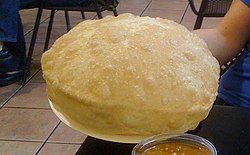

 | |
| Place of origin | Punjab |
|---|---|
| Region or state | Northern regions of the Indian subcontinent |
| Associated cuisine | India, Bangladesh, Pakistan, Punjabi |
| Main ingredients | Maida, dahi (yogurt), ghee or oil, yeast |
| Variations | Puri, Luchi |
Bhatoora (also known as batoora, bhatura, batura, or pathora) (Hindi: भटूरा, Punjabi: ਭਟੂਰਾ) is a fluffy deep-fried leavened sourdough bread originating from the Indian subcontinent.[1] It is commonly served as a midday meal or a breakfast dish in northern and eastern India.[1] Paired with chickpea curry (called choleorchanne), it forms a traditional dish called chole bhature.
This bread is like the puri bread but is made with leavened dough.[2]
A typical recipe includes all-purpose flour (maida), dahi (yogurt), ghee or oil, and either yeast or baking powder. Once kneaded well, the dough is left to rise, and then small balls of this dough are either hand-rolled or flattened using a rolling pin. The bread pieces are then deep fried until they puff up into a lightly browned, soft, fluffy bread, which is elastic and chewy.[3]
Bhatura is often eaten with yogurt, pickle, or vegetables. When eaten with chole, it forms a popular traditional dish known as chole bhature.[1][4]
A variation of this dish is to use semolina flour instead of all purpose flour. [5] Other variations include aloo bhatura (bhatura filled with potato) and paneer bhatura (bhatura filled with paneer).
A nonfried variant is the kulcha, which can be baked or cooked on a flat pan and is garnished with coriander leaves.
|
| |
|---|---|
| Main and side dishes |
|
| Snacks and sauces |
|
| Breads |
|
| Beverages |
|
| Sweetmeats |
|
| Bangladeshi diaspora |
|
| |
|
| ||
|---|---|---|
| Asia |
| |
| Europe |
| |
| Africa |
| |
| America |
| |
| ||
|
| ||||||||
|---|---|---|---|---|---|---|---|---|
| Sweet |
| |||||||
| Savory |
| |||||||
| Companies |
| |||||||
| Lists |
| |||||||
| See also |
| |||||||
| ||||||||
This Indian cuisine–related article is a stub. You can help Wikipedia by expanding it. |
This bread-related article is a stub. You can help Wikipedia by expanding it. |
This breakfast-related article is a stub. You can help Wikipedia by expanding it. |